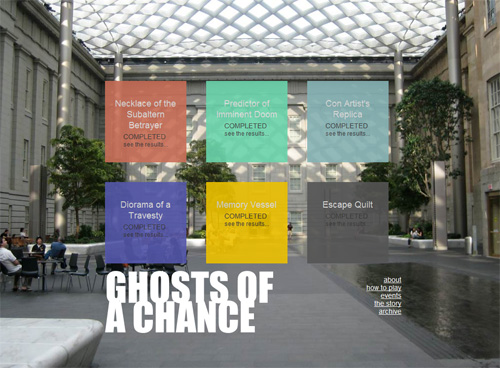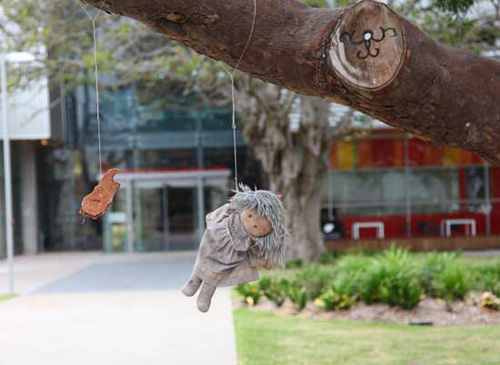This resource contains examples of alternate reality games (ARGs) created for museums, libraries, schools, and government agencies. Also included are links to related resources, designers, observers, and policy-makers.
Know of something that should be listed here? Please get in touch with me via the comments and I will update the resource.
Museums
Games
- Ghosts of a Chance (Smithsonian, 2008-2010) “We live in a world in which information and entertainment are customizable and immediately available. The Internet has become a larger part of everyday life, and so too have networked games, as people seek community, activity, a sense of achievement, and the chance to be part of something bigger . . . Museums can reach out to their audiences in more ways, using blogs, podcasts, video, and social media, but can they meaningfully engage visitors using games? In the fall of 2008, the Smithsonian American Art Museum hosted an Alternate Reality Game titled “Ghosts of a Chance.” We did this with three goals in mind: to broaden our audience, to do a bit of self-promotion, and, most importantly, to encourage discovery around our collections in a new, very interactive way. This paper will discuss the challenges that the museum faced, evaluate the successes and failures of each part of the game, and make recommendations for other museums interested in trying something similar.” (Archimuse)
- More on Ghosts of a Chance: Georgina Goodlander’s paper, Nina Simon’s blog writeup, Anika Gupta’s piece on Smithsonian.com and goSmithsonian, Washington Post coverage, and NPR’s coverage.
- PHEON (Multiple institutions, 2010) “For the past couple of months CityMystery has been building a new game, called PHEON. (A pheon is an ancient Greek arrowhead that has come to symbolize nimbleness of wit.) The purpose of our game is to celebrate (and reinforce) the American impulse to innovate. An economist friend of mine recently said that we have to “invent” our way out of our current mess. With PHEON I am promoting the idea that Americans understand innovation as a reoccurring utility of our democracy, one that matches our ability to adapt and succeed. PHEON’s subtext has to do with how ideas are passed along: how one person articulates a wish that another fulfills.” (“Sneak Preview of a New Museum Game“)
- More on PHEON: see Pass on the PHEON!.
- Many museums are also developing location-specific games and storytelling activities (like this) that don’t fit comfortably into the definition of an ARG. For some starting points for looking into these kinds of projects, see my locative media and ambient storytelling resources, and visit Nancy Proctor’s site, Museum Mobile.
Articles and discussions
- Reshaping the art museum June 2009 article from ArtNews: “Confronted with urgent demographic realities, art-museum directors are drawing on game theory, interactive technology, and a host of other new strategies to help people feel welcome, engaged, and emotionally fulfilled.”
- Smithsonian 2.0 “The two-day Smithsonian 2.0 gathering explores how to make SI collections, educational resources, and staff more accessible, engaging, and useful to younger generations (teenage through college students) who will largely experience them digitally. Over 30 creative people from the web and new media world will meet with 30 Smithsonian staff members to generate a vision of what a digital Smithsonian might be like in the years ahead.”
Libraries and Library Systems
Games
- Find Chesia (Carroll County MD Public Library, 2009) “Carroll County Public Library simply defined their ARG as a game played online and in the real world, where players solve puzzles, collect clues and objects, and ultimately find out about the mysterious Chesia. The library’s definition focused on the interactive story element and the promotion of technology literacy. Lynn Wheeler, Director of Carroll County Public Library, expressed pride in the project and the volunteers and staff who ‘have worked tirelessly to create delightful opportunities for teens to learn about and in turn use Web 2.0 technologies to create fun learning activities.’” (School Library Journal)
- Blood on the Stacks (Trinity University, 2006-2007) “Blood on the Stacks began in the spring of 2006, with a charge from Library Director Diane Graves to invent an orientation to follow in the footsteps of the hugely successful Harry Potter-themed orientations created by science librarian Barbara MacAlpine. Librarians Jeremy Donald, Clint Chamberlain and Jason Hardin created a mixed-media, digital/analog experience that treated the library as both a cyberspace and a bricks-and-mortar campus hotspot. Communication professor Aaron Delwiche supplied the idea of making the library orientation an ‘alternate reality game,’ where a fictional online narrative combines with real-world people, places, and events to create a game that blurs the boundary between the real and the imagine d, the online environment and physical reality.” (lib.trinity.edu)
Universities, Colleges and K-12
Games
- AFTRS/LAMP induction and orientation ARGs (Australian Film Television and Radio School, 2005-2009) “Mini Alternate Reality Games (mARGs), collaborative play and quests as part of LAMP residentials or AFTRS inductions.” Includes games designed by Gary Hayes and Christy Dena.
- ARGOSI (Manchester Metropolitan University/University of Bolton, 2008-2009) “Alternate Reality Games for Orientation, Socialisation and Induction (ARGOSI) was a JISC-funded project that ran from April 2008 to March 2009. It designed and piloted an Alternate Reality Game (ARG) to support the student induction process. This small-scale pilot project was . . . aimed to provide an engaging and purposeful alternative to traditional methods of introducing students to university life.”
- Skeleton Chase (Indiana University, 2008) “In late May [of 2008], Indiana University announced that it received a $185,000 grant from the Robert Wood Johnson Foundation to explore how interactive digital games can be designed to improve players’ health. . . The [alternate reality game produced with this grant] was a collaboration between professors Anne Massey (Kelley School of Business), Jeanne Johnston (Kinesiology Department), and Lee Sheldon (Telecommunications Department).” (ARGNet)
Articles and Discussions
- Alternate reality games for developing student autonomy and peer learning Nicola Whitton’s case study of the ARGOSI project at Manchester Metropolitan University: “This paper discusses the educational potential of alternate reality games (ARGs), a relatively new game format that takes place both online and in the real world over a number of weeks, and combines narrative and puzzles to develop a collaborative community. In this paper, first the concept of ARGs are described, including their history and composition, and their potential pedagogic benefits are discussed in relation to constructivism, student autonomy and peer learning.” (lick2008.wikispaces.com)
- See also: Nicola Whitton’s ARGOSI PowerPoint presentation from the 2008 Let’s Change the Game Conference.
- MacArthur Digital Media and Learning Competition: ARG proposals Play without Borders and Earthrise are two recent DML competition proposals for school-based ARGs.
- Peer Puppeteers: Alternate Reality Gaming in Primary Schools “In this paper I will be reporting on a crosscurricular multi-media literacy project undertaken in a large South London Primary School over two years, which represents one element of my ongoing research into the potential of Alternate Reality Gaming in Primary Education.” (Angela Colvert)
Government
- Federal multi-agency Alternative Reality Game “The general idea of a multi-agency ARG would be to use game play as a way of engaging citizens in an exploration of democratic ideals. It would also be a way to discover new connections between Federal agencies, and new ways of connecting citizens to their government.” (Smithsonian 2.0)
Designers, observers, and policy-makers
- ARGLE Angela Colvert’s research into the potential of alternate reality gaming in education.
- Center for the Future of Museums “Musings on the future of museums and society from Elizabeth Merritt, founding director of the Center for the Future of Museums, an initiative of the american association of museums”
- Georgina Goodlander Manager of the Luce Foundation Center (visible storage) at the Smithsonian American Art Museum.
- John Maccabbee Game designer/producer/writer; involved in Ghosts of a Chance and PHEON.
- MOERG “Alex Moseley is an Educational Designer at the University of Leicester. He is a learning and teaching practitioner, and conducts research into skills and subject teaching and support using paradigms from online games and social networks.”
- Museum Mobile Nancy Proctor’s MuseumMobile “is a forum for conversations about mobile interpretation – media & technology – for museums and cultural sites.”
- Nicola Whitton “I feel that the combination of gaming characteristics and lo-fi environment in ARGs are ideally suited to learning.”
- Nina Simon “[works] with museums to design exhibitions, programs, and online experiences that engage visitors as co-creators and community members, not just consumers.” Her design consultancy, Museum 2.0 is “focused on creating participatory, dynamic, audience-centered museum spaces.”
- NITLE “The National Institute for Technology in Liberal Education (NITLE) is a community-based, non-profit initiative that helps liberal arts colleges and universities explore and implement digital technologies.”
- Playtime Anti-Boredom Society Creators of SF0 and many other exciting projects; involved in production of Ghosts of a Chance.
See also: ARGology.org: ARGs in Education & Training, IGDA ARG SIG Whitepaper 2006, IGDA ARG SIG wiki: Educators and ARGs, Google keyword search [1] [2] [3]
http://remotedevice.net/blog/args-in-institutions/




No comments:
Post a Comment